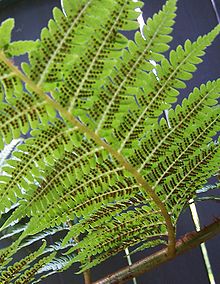Dicksonia
| Dicksonia | ||||||||||||
|---|---|---|---|---|---|---|---|---|---|---|---|---|

Australian pocket fern ( Dicksonia antarctica ) in Nunniong, Australia |
||||||||||||
| Systematics | ||||||||||||
|
||||||||||||
| Scientific name | ||||||||||||
| Dicksonia | ||||||||||||
| L'Hér. |
Dicksonia is a genus of tree ferns (Cyatheales). They are also called pocket ferns . The generic name honors the English-Scottish gardener and botanist James Dickson (1738-1822).
features
Dicksonia are terrestrial, large tree-shaped ferns. The rhizome or stem axis are upright and have a tuft of fronds at the top. The stem axis is a dictyostele and is consolidated by strong sclerchymal ligaments. Young shoot sections and the leaf bases are covered by long, fine hair. The stems of the leaf fronds are short to medium long. There are three separate curved bundles of vessels at the base of the stalk, which unite towards the tip. The blade spindle is raised on the upper side (adaxial). The leaf blade is tripinnate or pinnately lobed. The fertile leaflets are more lobed than the sterile ones.


The sori are round and submarginal. They are protected by the bent-back leaf blade (false indusium ) and have a sack-shaped inner indusium. The spores are trilted and have a smooth or sculptured surface.
distribution
The genus occurs in tropical America, the Juan Fernández Islands , in Malesia , New Caledonia , Fiji , Australia and New Zealand . They grow in tropical and subtropical rainforests and humid mountain forests.
Culture
The starchy pulp of Dicksonia antarctica was used as food by the natives of Tasmania . Dicksonia antarctica is a popular ornamental plant in mild winter areas of England, Cornwall, the USA and Japan. They give preference to old specimens with tall trunks that are removed from Australian forests, which has resulted in a threat to the species in the wild. Dicksonia antarctica is easy to propagate, but it is economically unattractive because of its slow growth. In Tasmania, the removal of wild plants is monitored by the Forest Practices Authority and is subject to a Tree Fern Management Plan .
Systematics
There are around 30 types:
- Australian pocket fern ( Dicksonia antarctica Labill. ): Endemic to Australia, southeastern Queensland, eastern New South Wales, Australian Capital Territory, southern Victoria, and Tasmania
- Dicksonia arborescens L'Hér. : It occurs on St. Helena .
- Dicksonia archboldii Copel. : It occurs in Indonesia.
- Dicksonia baudouinii E. Fourn. : It occurs in New Caledonia.
- Dicksonia berteroana (Colla) Hook. : It occurs on the Juan Fernandez Islands.
- Dicksonia blumei (Kunze) T. Moore : It occurs in Sumatra, Java and Sulawesi.
- Dicksonia brackenridgei Mett. : It occurs in Fiji and Samoa.
- Dicksonia domingensis Desv. : It occurs in Hispaniola.
- Dicksonia externa C. Chr. & Skottsb. : It occurs on the Juan Fernandez Islands.
- Felt pocket fern ( Dicksonia fibrosa Colenso ), home: New Zealand.
- Dicksonia grandis Rosenst. : It occurs in New Guinea.
- Dicksonia herbertii W. Hill : endemic to northeast Queensland
- Dicksonia hieronymi Brause : It occurs in New Guinea.
- Dicksonia lanata Colenso : It occurs in New Zealand.
- Dicksonia lanigera Holttum : It occurs in New Guinea.
- Dicksonia mollis Holttum : It occurs in Sulawesi, Kalimantan, Sabah and the Philippines.
- Dicksonia sciurus C. Chr . : It occurs in Papua New Guinea.
- Dicksonia sellowiana Hook. : It occurs in Mexico, Guatemala, El Salvador, Honduras, Nicaragua, Costa Rica, Colombia, Ecuador, Venezuela, Bolivia, Peru, Argentinian, Paraguay and Uruguay.
- New Zealand pocket fern ( Dicksonia squarrosa (G. Forst.) Sw. ), Origin: New Zealand.
- Dicksonia stuebelli Hieron. : It occurs in Peru and possibly also in Ecuador.
- Dicksonia thyrsopteroides Mett. : It occurs in New Caledonia.
- Dicksonia youngiae C. Moore ex Baker : endemic to southeastern Queensland and northeastern New South Wales
Sources and further information
- Australian National Herbarium
- Entry in the Flora of Australia online
- Walter Erhardt among others: The big pikeperch. Encyclopedia of Plant Names . Volume 2. Verlag Eugen Ulmer, Stuttgart 2008. ISBN 978-3-8001-5406-7
Individual evidence
- ↑ http://www.dpiw.tas.gov.au/inter.nsf/Attachments/LJEM-7CV6M4/$FILE/Dicksonia%20antarctica%20Notesheet.pdf
- ↑ Archive link ( Memento of the original from March 18, 2013 in the Internet Archive ) Info: The archive link was inserted automatically and has not yet been checked. Please check the original and archive link according to the instructions and then remove this notice.
- ↑ http://www.dpiw.tas.gov.au/inter-nsf/Attachments/LJEM-7CV6M4/$FILE/Dicksonia%20antarctica%20Notesheet.pdf
- ↑ http://www.dpiw.tas.gov.au/inter-nsf/Attachments/LJEM-7CV6M4/$FILE/Dicksonia%20antarctica%20Notesheet.pdf
- ↑ List of species on GRIN
- ↑ a b c Entry in the Flora of Australia online
- ↑ a b c d e f g h i j k l m n o p q r s t u Dicksonia in the Germplasm Resources Information Network (GRIN), USDA , ARS , National Genetic Resources Program. National Germplasm Resources Laboratory, Beltsville, Maryland. Retrieved February 24, 2019.
